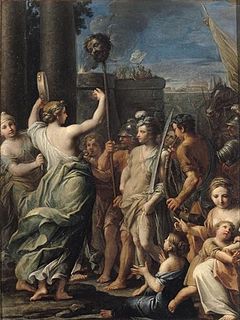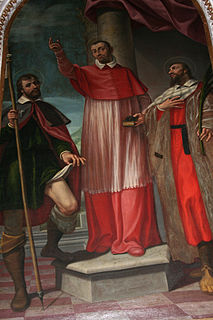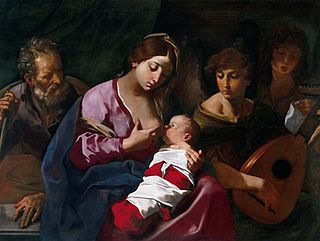Giovanni Segala | |
|---|---|
| Born | 1663 |
| Died | 1720 |
| Nationality | Venetian |
| Occupation | Painter |

Giovanni Segala (1663-1720) was a Venetian painter.
Giovanni Segala | |
|---|---|
| Born | 1663 |
| Died | 1720 |
| Nationality | Venetian |
| Occupation | Painter |

Giovanni Segala (1663-1720) was a Venetian painter.
Giovanni Segala was born in Murano in 1663. [1] He studied under Antonio Zanchi. [2] He was also a pupil of Pietro della Vecchia and was influenced by his contemporary Gregorio Lazzarini. He undertook work for Venetian churches such as San Pantalon and San Martino. [1] The San Clemente Church on the Isola di San Clemente has one of his paintings. [3] He gained a solid reputation for his depictions of historical subjects. [2] Between 1688 and 1692 he worked for the Marquis von Platen in Hanover. [1]
Segala was one of the more distinguished of the Venetian artists of the 18th century, although not the equal of masters such as Giovanni Battista Tiepolo or Sebastiano Ricci. [4] He developed a fluid style with delicate colors and a soft light. [1] He followed his teachers in using deep shadows in his work, perhaps excessively, but made skilled use of illumination. The picture of the Conception, which he made for the college of La Carità, was highly praised by Zanetti and is said to be equal to those of the finest artists of his day. [5]

Guglielmo Caccia called il Moncalvo was an Italian painter, active in a Mannerist style depicting sacred subjects.

Carlo Ridolfi (1594–1658) was an Italian art biographer and painter of the Baroque period.

Alessandro Magnasco, also known as il Lissandrino, was an Italian late-Baroque painter active mostly in Milan and Genoa. He is best known for stylized, fantastic, often phantasmagoric genre or landscape scenes. Magnasco's distinctive style is characterized by fragmented forms rendered with swift brushstrokes and darting flashes of light.

Lorenzo Pasinelli was an Italian painter active mainly in Bologna during the late Baroque period.

Gaspare Diziani was an Italian painter of the late-Baroque or Roccoco period, active mainly in the Veneto but also in Dresden and Munich.

Giuseppe Angeli was an Italian painter of the late-Baroque, known for depicting both genre and religious subjects.

Cesare Aretusi was an Italian painter of the late-Renaissance period.

Giacomo Boni was an Italian painter of the late-Baroque period, active mainly in Genoa.
Alfonso Rivarola was an Italian painter of the Baroque period, active mainly in Ferrara, where he was born. He is also known as il Chenda because of an inheritance he received from someone with that name.

Giovanni Paolo Cavagna was an Italian painter of the late-Renaissance period, active mainly in Bergamo and Brescia.
Giovanni Battista Cremonini was an Italian painter of the Renaissance period.

Giuseppe Palmieri was an Italian painter of the late Baroque period.

Luigi Quaini (1643–1717) was an Italian painter of the Baroque period.

Orazio Riminaldi was an Italian painter who painted mainly history subjects in a Caravaggist style.

Flaminio Torre (1620–1661) was an Italian Baroque painter of the Bolognese School, active during the Baroque period.
Domenico Bocciardo was an Italian painter of the Baroque period, active in Genoa.Native of Finale Ligure, but died in Genoa. He was a pupil of Giovanni Maria Morandi in Rome, but upon the death of Morandi in 1717, went to Genoa to work. He painted a San Giovanni baptizing the Multitude for the church of San Paolo in Genoa.
Baldassare Bianchi was an Italian painter of the Baroque period.
Giovanni Maria Tamburini was an Italian painter of the Baroque period.
Giovanni Agostino Ratti (1699–1755) was an Italian painter of the late-Baroque period.
Pietro Paolo Raggi (1646–1724) was an Italian painter of the Baroque period, active mainly in Northern Italy.
Citations
Sources
| Wikimedia Commons has media related to Giovanni Segala . |